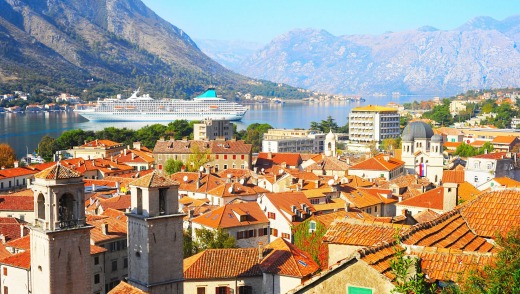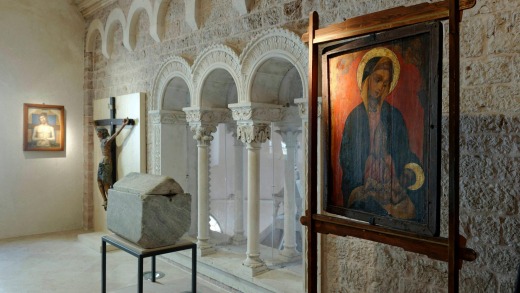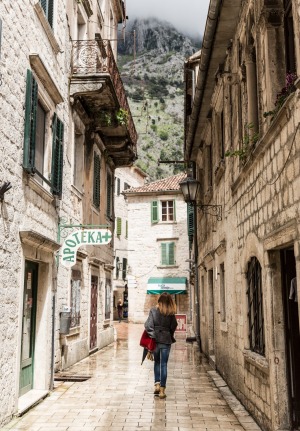Montenegro, the bizarre 1980s comedy from Serbian director Dusan Makavejev – a veritable Grimm's fairytale of sex and violence – piqued my interest in that mysterious place.
The film, though not actually set there, showed a surreal, passionate Slavic world representing what I thought must certainly be Montenegro. What was this extraordinary realm that gained independence in 2006, with only 624,000 people, bordering Croatia, Serbia, Bosnia and Herzegovina, Kosovo and Albania?
I'm asking that question as our ship puts on its right indicator and veers off the Adriatic into the 30-kilometre long cul-de-sac that is Boka Kotorska, the Bay of Kotor, a hidden sea road that leads us all the way to Kotor, Montenegro.

It's 5.45am when we slide between jade hills onto the polished waters of Europe's southernmost fjord, with 105 kilometres of indented coastline. But glaciers never crept this far south.
The Boka – Italian for mouth – is actually a ria or drowned river valley (like Sydney's Georges River), made up of four graceful interconnected bays ending at the old town of Kotor. Still, it's a fjord by any other name.
As our ship glides between narrowing vertiginous rock faces, laced with cypress and oak, a fog descends, as can happen in creepy, fantastical tales spun by avant garde Serbian directors, German folklorists or the tellers of Nordic sagas.

We pull our duvet a little higher as something bumps against the hull. Perhaps we simply had one too many cocktails the night before on this indulgent APT Ancient Mediterranean cruise, that has introduced us to a string of Aegean and Adriatic jewels.
It's a mistake to invent a country's story before you visit. We burst from the fog into a place that is not Norway, nor Germany, nor Switzerland, nor Serbia, nor civil war Yugoslavia, nor Disneyland. It is itself – Kotor, Montenegro, world heritage-listed, inhabited since 3000BC, and a very lovely self it is too. It's not surprising to learn Lonely Planet named Kotor its No.1 city to visit in 2016.
Read: Lonely Planet's top places to visit in 2016 named

Kotor sits like Flam at the end of Norway's Sognefjord. But in Flam you won't find Mediterranean trees and flowers so profuse they scent the air, mild winters, warm water, Venetian villas, monasteries and 4.5 kilometres of city wall fortifications. Those walls, interspersed with churches, forts and gates, miraculously have survived invasions and earthquakes. Kotor is renowned for having repulsed the Ottoman-Turkish pirate Barbarossa.
We approach our berth near Kotor's Sea Gate, entranced by the flying wedge of red-roofed old town tucked between two rivers and hard up against the sheer rocks of Mount Sveti Ivan (St John). About 1350 stairs snake 260 metres above Kotor to the Tower of Sveti Ivan. You can slog up for $5, and masochists can keep going up the 940-metre Ladder of Kotor to the high Krstac Pass.
We, however, are happy to loiter at sea level, exploring the town, coveted by kings and pirates, that once sat at the crossroads of maritime and mainland routes leading to rich silver, lead and copper mines.
It's a miniature Dubrovnik, a charming medieval milieu of winding marble streets, squares, piazzas and piazzetas with an equally charming genesis. The cave-dwelling fairy Alkima advised the town should not be built on the mountain. "There is no life for you without the sea," she foretold. And so it was.
Maritime Kotor has benefited from many civilisations – the Illyrians, Romans, Byzantines and Venetians left behind a glittering treasure chest of antiquities, art and architecture.
Grab a guidebook and spend time in the many churches, particularly the Cathedral of St Tryphon built in 1166, one of Europe's oldest cathedrals. The Romanesque-Gothic stone ciborium above the high altar is a masterpiece, as is the altar painting, the work of Kotor's goldsmiths. Revel in the 14th-century Greek frescoes.
Each square offers an array of Gothic, Byzantine, Renaissance and Baroque architecture, beginning with the main Square of Arms and navigating other charmingly named squares – Flour, Milk, Sailors' Revolt, Brotherhood and Unity. The Town Clock Tower is a mini Pisa, inclining to the west thanks to earthquakes. Venetian palaces line the streets pointing to a time of great riches and civilisation.
The Maritime Museum housed in the Baroque palace of the Grgurina family traces the complex maritime history. Spend as much time as you can in this lovely town with its friendly citizens, not forgetting to sample the wood-fired Balkan meat and seafood in the open-air piazzas.
As the sun sets over Kotor, we sail away, gliding past the picture-perfect town of Perast and its two islets – Sveti Juraj (aka Islet of the Dead) and Our Lady of the Rock adorned with the life's work of one of the greatest Baroque painters and son of Kotor – Tripo Kokolja.
See www.aptouring.com.au; www.kotor.montenegro.travel/en/nature-kotor
APT's 15-day Adriatic & Aegean Odyssey 'Boutique Collection' all-inclusive small ship coastal cruise from Venice to Istanbul (includes Kotor) aboard the MS Island Sky (departures in April, July and August 2016) is priced from $13,295 per person. Phone 1300 196 420
Emirates flies daily from Sydney, Melbourne and Brisbane to Venice, the starting point of the cruise, via Dubai, with return flights from Istanbul, where the cruise concludes, via Dubai. See www.emirates.com
See also: One Australian hotel makes world's top 100 list